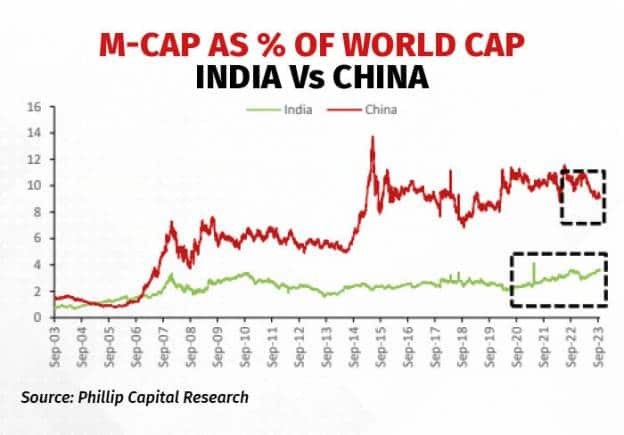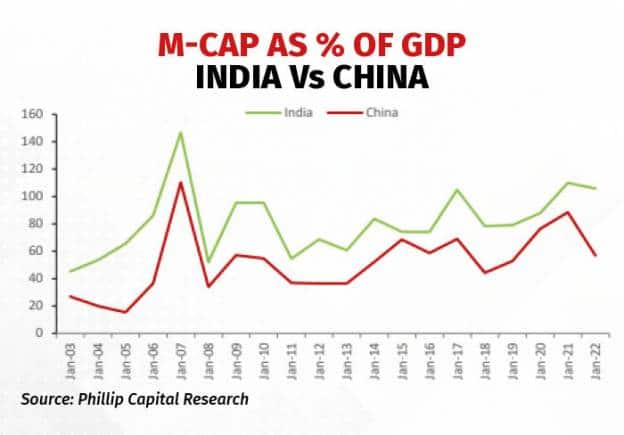



If we look at emerging markets, two big names come to mind – China and India. Both these nations underwent bouts of volatility as COVID-19 hit, and returned to a tough macro-economic environment.
A Phillip Capital analysis of whether India or China fared better in 2020-2023 to date showed that the former’s market capitalisation (m-cap) grew at a faster rate than the latter due to India’s increased appeal among foreign investors.
“India’s one-year forward average price-to-earnings (PE) ratio increased to 20.6 times over 2021-23 from an average 14x PE multiple in 2006-10, whereas China’s one-year forward PE declined to 12x over 2021-23, compared to 18.6x in 2006-10,” wrote analysts at Phillip Capital in a recent note.
This trend, they added, indicated a broader trend of increasing confidence in India’s economic potential and investment case.
Also read: China’s rise is reversing
Going ahead, analysts predict Nifty to reach 35,000-40,000 by 2030-32, based on conservative valuations and decent earnings growth.
On the other hand, Chinese corporate giants that were valued above the mid-teens during 2000-10 lost value as economic growth tapered off and the investment landscape witnessed a shift from optimism to caution.
World M Cap share: India on an uptrend, China falters
Notably, China holds a dominant position in the global equity market, ranking among the top three in terms of market capitalisation (m-cap) and the value of shares traded.
During its high GDP growth phase, it experienced substantial m-cap growth, with a multi-fold increase in index market cap, as a percentage of the world M Cap. However, in recent years, China's growth slowed down due to its receding economy, exacerbated by a property market slump.
Over 2020-2023 so far, China’s M cap shrank by 16 percent and its share with the world M Cap declined to 9 percent in October 2023, data suggested. (see chart)

In contrast, India's stock market saw a sharp up move after COVID-19, capturing a higher global M Cap share. India’s M Cap grew 47 percent over 2020-2023, while the world M Cap was almost up by 30 percent to 3.6 percent in October 2023.
Also read: Nifty target for 2024 at 21,800; India’s core fundamentals very strong: Goldman Sachs' Timothy Moe
Interestingly, the gap between China and India in terms of m-cap has narrowed. While China’s market was 4x of India’s value in 2020, the cap is now 2.5x. (see chart)

Looking at the market capitalisation, as a percentage of GDP in China and India in two years, also reveals interesting economic trends and investor sentiments. (see chart)

For China, the average market capitalisation, as a percentage of GDP, dropped to 57 percent in 2022 from 88.5 percent in 2021, weighed by the underperformance of the Chinese stock market.
Meanwhile, India’s average market capitalisation, as a percentage of GDP, surged to 110 percent in 2022 from 106 percent in 2021, driven by robust participation from foreign institutional investors (FIIs), domestic institutional investors (DIIs), and retail investors.
China’s pain, India’s gain?
Over the years, exports have played a pivotal role in China’s growth story. China’s exports to the world market is 8x higher than India’s. However, recently, Chinese exports to other countries have dwindled due to lower global demand, exit of foreign investment, and relocation of supply chains.
Analysts at Phillip Capital said that with China’s lower share of world exports, the scope for India to improve its trade competence is immense. Even a slight dent in Chinese exports could reap huge benefits for India as a potential export partner, they added.
Also read: Risks to India fading away automatically; God is Indian it seems, says Nilesh Shah
Among mechanical and electrical products, strong double-digit growth turned weak in China. China’s mobile exports were seen growing at 17 percent in FY22, compared to 54 percent in India during the same period. The momentum continued in FY23 as well, with India’s exports booming with 133 percent, while China’s exports declined by 3 percent.
“Notably, the sectors where China’s export share has dwindled are the ones that India is currently focusing on to increase its manufacturing share. India’s exports of these products could see a sustained increase over the coming years as more manufacturing capacities shift to the country,” the brokerage firm added.
Thus, India’s focus on capex, its demographic dividend, government support, and free trade agreements are key to an export-oriented manufacturing base in the country.
Disclaimer: The views and investment tips expressed by investment experts on Moneycontrol.com are their own and not those of the website or its management. Moneycontrol.com advises users to check with certified experts before making any investment decisions.
Discover the latest Business News, Sensex, and Nifty updates. Obtain Personal Finance insights, tax queries, and expert opinions on Moneycontrol or download the Moneycontrol App to stay updated!
Find the best of Al News in one place, specially curated for you every weekend.
Stay on top of the latest tech trends and biggest startup news.